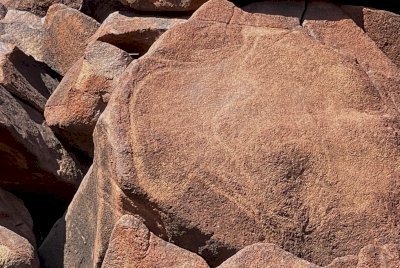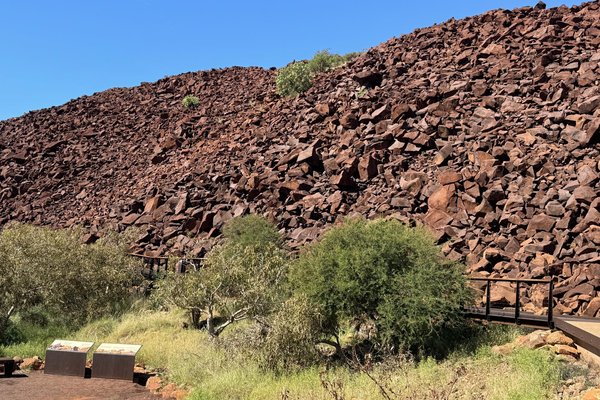Australia
Murujuga Cultural Landscape
Murujuga Cultural Landscape is the homeland of the Ngurra-ra Ngarl Aboriginal groups.
The area on the Burrup Peninsula holds a large and diverse collection of petroglyphs. Especially notable are the depictions of human figures; they continue to be part of the traditions and beliefs of the Ngurra-ra Ngarl.
Community Perspective: Joel visited in 2022 and found it one of the most impressive collections of petroglyphs he had ever seen. However, it's pretty remote, even by Australian standards.
Site Info
Official Information
- Full Name
- Murujuga Cultural Landscape (ID: 1709)
- Country
- Australia
- Status
-
Inscribed 2025
Site history
History of Murujuga Cultural Landscape
- 2025: Inscribed
- As a CL, on criterion 1,3 and 5
- 2025: Advisory Body overruled
- ICOMOS wanted Referral to further study and limit impact of the industries on the petroglyphs
- 2024: Incomplete - not examined
- 2020: Added to Tentative List
- Added to tentative list
- Type
- Cultural
- Criteria
- i
- iii
- v
Links
- UNESCO
- whc.unesco.org
All Links
UNESCO.org
- whc.unesco.org — whc.unesco.org
News Article
- June 3, 2025 theguardian.com — Australia to lobby Unesco over barring of ancient rock site from world heritage list due to Woodside emissions
- May 28, 2025 abc.net.au — Australia's largest gas project approved for life extension to 2070
- June 6, 2023 bradshawfoundation.com — Murujuga rock art is at risk
Community Information
- Community Category
- Archaeological site: Rock Art
- Cultural Landscape: Continuing
Travel Information
Recent Connections
-
Underwater Archaeology
"Most of the cultural landscape is loca…
-
Archipelagos
encompasses the Dampier Archipelago’s 4…
-
Petroglyphs
"The petroglyphs, which represent the m…
Connections of Murujuga Cultural Landscape
- Geography
-
-
Archipelagos
encompasses the Dampier Archipelago’s 42 islands
-
- Human Activity
-
-
Petroglyphs
"The petroglyphs, which represent the most numerous features of the site" (ICOMOS ev)
-
- Science and Technology
-
-
Underwater Archaeology
"Most of the cultural landscape is located underwater today." (AB ev) (see also this link)
-
News
- theguardian.com 06/03/2025
- Australia to lobby Unesco over bar…
- abc.net.au 05/28/2025
- Australia's largest gas project ap…
- bradshawfoundation.com 06/06/2023
- Murujuga rock art is at risk
Community Reviews
Show full reviewsJoel on the Road
Murujuga Cultural Landscape - The Best Rock Art You've Never Heard Of
Murujuga Cultural Landscape (Inscribed)

I'm going to put it out there right at the start of this review: the Murujuga Cultural Landscape is one of the most impressive collections of petroglyphs (rock carvings) I've ever seen. It would be justifiably world-renowned if it were located on other continents, and certainly ranks well above many of the other rock art collections already inscribed on the World Heritage List. So what is it?
The cultural landscape is centred on Murujuga National Park, part of the Burrup Peninsula in the remote Pilbara region of Western Australia. It's located on the traditional lands of the Ngarluma, Yindjibarndi, Yaburara, Mardudhunera, and Wong-Goo-Tt-Oo peoples, collectively known as the Ngarda-Ngarli (pron "nahda nahli"). The national park is about 37,000 hectares, so it's not an extremely large area, but it's packed with an estimated one million petroglyphs. It's believed to be the densest collection of hunter-gatherer petroglyphs anywhere in the world. What's truly amazing about Murujuga is the incredible variety of petroglyphs, in both age and subject matter: the oldest petroglyphs here have been dated at around 40,000 years old, while some are as recent as the 19th century.
Petroglyphs of humans are quite common with a variety of imagery, ranging from static figures to abstract faces, hunting scenes and ceremonial activities. You can also see plenty of spiritual art telling stories of the Marrga, the ancestral beings who created the world during the Dreamtime.
But it's the imagery of animals at Murujuga that we found most striking. The sheer number …
Keep reading 0 comments

